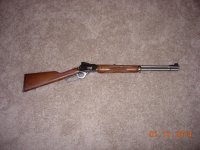Marlin uses rifling with a 38" twist, which works best with bullets 300 grains or less. (Winchester and others use a 20" twist). Newer rifles have conventional Ballard rifling rather than microgroove, and .431 lead bullets work fine. Jacketed bullets have no problem either, sized at .429.
If the feed is rough - any stickiness or excessive scratching of the cases - look first at the extractor. It is stamped metal, and the Marlin uses a controlled feed. The rim should slide smoothly under the extractor and push straight into the chamber - like butter. If not, break it down and stone the lower edge of the extractor to remove the sharp edge.
Some people recommend prying between the bolt face and hook to bend the extractor out from the end of the bolt, making more space, but I've found stoning is all that's needed.
The OEM trigger tends to break at about 6#, with a loose (floppy) takeup. The best solution is to drop in a "Happy Trigger", which breaks at 2.5# to 3#. It's a two part trigger (for safety), and the "Happy Trigger" joins the parts with a bronze bushing. There is a spring to take up slack and eliminate the Marlin "floppy" trigger. The sear surfaces are EDC and very smooth.
You know it when you're hurling a 240 grain slug down range at 1800 fps (typically 300 fps bump). My first thoughts were "I actually put these through a revolver?" A Marlin will handle more pressure than a S&W revolver, but I keep mine legal for a 629 out of due diligence. If you have a Ruger Blackhawk, you can heat things up a bit. I use RNFP bullets (or HPs) for clean feeding. SWC bullets tend to hang up a bit when chambering, as to swaged rather than rolled crimps. I have no leading problems using hard cast (e.g., Oregon Trails) lead bullets.


